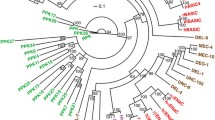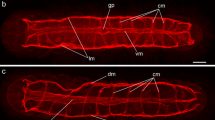Abstract
A family of peptides with the carboxy-terminus Arg-Phe-amide has been localized to specific subpopulations of neurons in every cnidarian species examined. These neurons are typically sensory in character or are associated with smooth muscle. Although a transmitter role for these peptides has been suggested for anthozoans at neuromuscular synapses, no such evidence is available for hydrozoans. Instead there is evidence that RF-amides can be modulators of neuronal activity which takes the form of a biphasic (inhibitory then excitatory) response in vivo, while in vitro only the inhibitory response is seen. Voltage clamp studies of identified motor neurons showed large, transitory outward currents when Pol-RF-amide peptide was applied.
Similar content being viewed by others
References
Anctil, M., 1987. Bioactivity of FMRF-amide and related peptides on a contractile system of the coelenterate Renilla kollikeri. J. comp. Physiol. 157: 31–38.
Anctil, M., D. Boulay & L. LaRivière, 1982. Monoaminergic mechanisms associated with control of luminescence and contractile activities in the coelenterate, Renilla kollikeri. J. exp. Zool. 223: 11–24.
Anctil, M., G. Germain & L. LaRivière, 1984. Catecholamines in the coelenterate Renilla kollikeri. Uptake and radioautographic localization. Cell Tissue Res. 238: 69–80.
Anderson, P. A. V. & A. N. Spencer, 1989. The importance of cnidarian synapses for neurobiology. J. Neurobiol. 20: 435–457.
Batham, E. J., C. F. A. Pantin & E. A. Robson, 1960. The nerve-net of the anemone Metridium senile; the mesenteries and the column. Q. JI microsc. Sci. 101: 487–510.
Bodenmüller, H. & H. C. Schaller, 1981. Isolation and amino acid sequence of a morphogenic peptide from Hydra. Nature, Lond. 293: 579–580.
Carlberg, M. & E. Rosengren, 1985. Biochemical basis for adrenergic neurotransmission in coelenterates. J. comp. Physiol. B 155: 251–255.
Castano, P. & S. Rossi, 1978. Cytochemical, ultrastructural and fluorescence study of the nervous system of Hydra sp. J. submicrosc. Cytol. 10: 381–395.
Chung, J. M., A. N. Spencer & K. H. Gahm, 1989. Dopamine in tissues of the hydrozoan jellyfish Polyorchis penicillatus as revealed by HPLC and GC/MS. J. comp. Physiol. B 159: 173–181.
Cottrell, G. A., 1982. FMRF-amide neuropeptides simultaneously increase and decrease K+ currents in an identified neurone. Nature, Lond. 296: 87–89.
Dahl E. B. Falck, C. von Mecklenburg & H. Myhrberg, 1963. An adrenergic nervous system in anemones. Q. JI microsc. Sci. 104: 531–534.
De Waele, J. P., M. Anctil & M. Carlberg, 1987. Biogenic catecholamines in the cnidarian Renilla kollikeri: radioenzymatic and chromatographic detection. Can. J. Zool. 65: 2458–2465.
Graff, D. & C. J. P. Grimmelikhuijzen, 1988. Isolation of <Glu-Ser-Leu-Arg-Trp-NH2, a novel neuropeptide from sea anemones. Brain Res. 442: 354–358.
Grimmelikhuijzen, C. J. P., 1983. FMRF-amide immunoreactivity is generally occurring in the nervous system of coelenterates. Histochemistry 78: 361–381.
Grimmelikhuijzen, C. J. P., 1985. Antisera to the sequence Arg-Phe-amide visualise neuronal centralization in hydroid polyps. Cell Tissue Res. 241: 171–182.
Grimmelikhuijzen, C. J. P. & D. Graff, 1986. Isolation of <Glu-Gly-Arg-Phe-NH2 (Antho-RF-amide), a neuropeptide from sea anemones. Proc. natn. Acad. Sci. U.S.A. 83: 9817–9821.
Grimmelikhuijzen, C. J. P. & A. Groeger, 1987. Isolation of the neuropeptide pGlu-Gly-Arg-Phe-amide from the pennatulid Renilla kollikeri. FEBS Lett. 211: 105–108.
Grimmelikhuijzen, C. J. P. & A. N. Spencer, 1984. FMRFamide immunoreactivity in the nervous system of the medusa Polyorchis penicillatus. J. comp. Neurol. 230: 361–371.
Grimmelikhuijzen, C. J. P., K. Dierickx & G. J. Boer, 1982b. Oxytocin/Vasopressin-like immunoreactivity is present in the nervous system of Hydra. Neuroscience 7: 3191–3199.
Grimmelikhuijzen, C. J. P., G. J. Dockray & L. P. C. Schot, 1982a. FMRF-amide-like immunoreactivity in the nervous system of Hydra. Histochemistry 73: 499–508.
Grimmelikhuijzen, C. J. P., G. J. Dockray & N. Yanaihara, 1981c. Bombesin-like immunoreactivity in the nervous system of Hydra. Histochemistry 73: 171–180.
Grimmelikhuijzen, C. J. P., D. Graff & A. N. Spencer, 1988a. Structure, location and possible actions of Arg-Phe-amide peptides in coelenterates. In M. C. Thorndyke & G. J. Goldsworthy (eds), Neurohormones in Invertebrates. Soc. exp. Biol. Sem. Ser. 33, Cambridge University Press, Cambridge: 199–217.
Grimmelikhuijzen, C. J. P., A. N. Spencer & D. Carré, 1986. Organization of the nervous system of physonectid siphonophores. Cell Tissue Res. 246: 463–479.
Grimmelikhuijzen, C. J. P., R. E. Carraway, Å. Rökaeus & F. Sundler, 1981b. Neurotensin-like immunoreactivity in the nervous system of Hydra. Histochemistry 72: 199–209.
Grimmelikhuijzen, C. J. P., M. Hahn, K. L. Rinehart & A. N. Spencer, 1988b. Isolation of <Glu-Leu-Leu-Gly-Gly-ArgPhe-NH2 (pol-RF-amide), a novel neuropeptide from hydromedusae. Brain Res. 475: 198–203.
Grimmelikhuijzen, C. J. P., A. Balfe, P. C. Emson, D. Powell & F. Sundler, 1981a. Substance P-like immunoreactivity in the nervous system of Hydro. Histochemistry 71: 325–333.
King, M. G. & A. N. Spencer, 1979. Gap and septate junctions in the excitable endoderm of Polyorchis penicillatus (Hydrozoa: Anthomedusae). J. Cell Sci. 36: 391–400.
Koizumi, O., J. D. Wilson, C. J. P. Grimmelikhuijzen & J. A. Westfall, in press. Ultrastructural localization of RF-amide-like peptides in neuronal dense-cored vesicles in the peduncle of Hydra. J. exp. Zool.
Mackie, G. O., 1976. The control of fast and slow muscle contractions in the siphonophore stem. In G. O. Mackie (ed.), Coelenterate Ecology and Behavior. Plenum Press, N.Y.: 647–659.
Mackie, G. O. & W. K. Stell, 1984. FMRF-amide-like immunoreactivity in the neurons of medusae. Am. Zool. 24: 36A.
Mackie, G. O., C. L. Singla & W. K. Stell, 1985. Distribution of nerve elements showing FMRF-amide-like immunoreactivity in Hydromedusae. Acta. zool. 66: 199–210.
Martin, S. M. & A. N. Spencer, 1983. Neurotransmitters in coelenterates. Comp. Biochem. Physiol. C 74: 1–14.
Martin, V. J., 1988. Development of nerve cells in hydrozoan planulae: II. Examination of sensory cell differentiation using electron microscopy and immunocytochemistry. Biol. Bull. 175: 65–78.
McFarlane, I. D., D. Graff & C. J. P. Grimmelikhuijzen, 1987. Excitatory actions of antho-RF-amide, and anthozoan neuropeptide, on muscles and conducting systems in the sea anemone Calliactis parasitica. J. exp. Biol. 133: 157–168.
Przysiezniak, J. & A. N. Spencer, 1989. Primary culture of identified neurones from a cnidarian. J. exp. Biol. 142: 97–113.
Ruben, P., J. W. Johnson & S. Thompson, 1986. Analysis of FMRF-amide effects on Aplysia bursting neurons. J. Neurosci. 6: 252–259.
Satterlie, R. A., 1985. Central generation of swimming activity in the hydrozoan jellyfish Aequorea aequorea. J. Neurobiol. 16: 41–55.
Spencer, A. N., 1988. Effects of Arg-Phe-amide peptides on identified motor neurons in the hydromedusa Polyorchis penicillatus. Can. J. Zool. 66: 639–645.
Spencer, A. N. & S. A. Arkett, 1984. Radial symmetry and the organization of central neurones in a hydrozoan jellyfish. J. exp. Biol. 110: 69–90.
Venturini, G., O. Silei, G. Palladini, A. Carolei & V. Margotta, 1984. Aminergic neurotransmitters and adenylate cyclase in Hydra. Comp. Biochem. Physiol. 78: 345–348.
Westfall, J. A., 1973. Ultrastructural evidence for an granulecontaining sensory-motor-interneuron in Hydra littoralis. J. Ultrastruct. Res. 42: 268–282.
Wood, J. G. & T. L. Lentz, 1964. Histochemical localization in Hydra and in the sea anemone. Nature, Lond. 201: 88–90.
Zachary, I., P. J. Woll & E. Rozengurt, 1987. A role for neuropeptides in the control of cell proliferation. Devl Biol. 124: 295–308.
Author information
Authors and Affiliations
Rights and permissions
About this article
Cite this article
Spencer, A.N. Peptides in the Hydrozoa: are they transmitters?. Hydrobiologia 216, 565–571 (1991). https://doi.org/10.1007/BF00026514
Issue Date:
DOI: https://doi.org/10.1007/BF00026514




